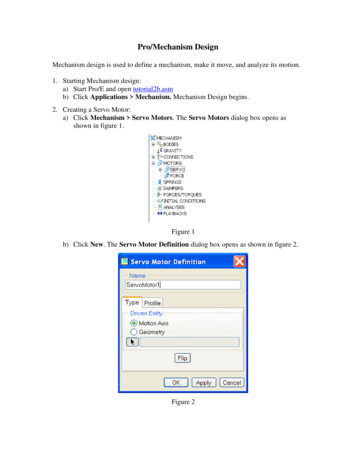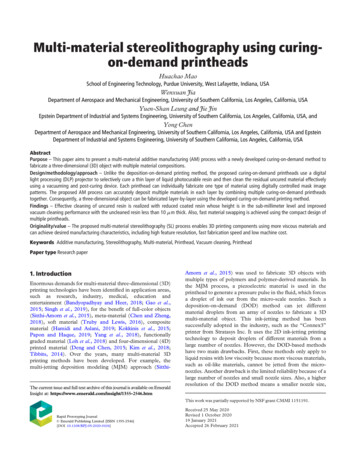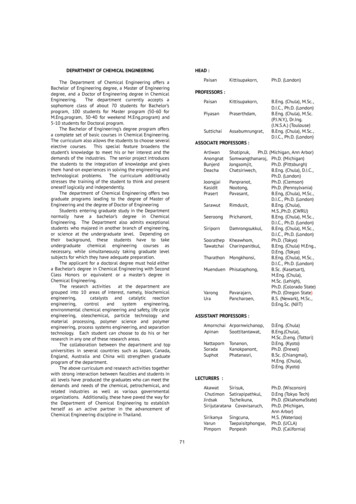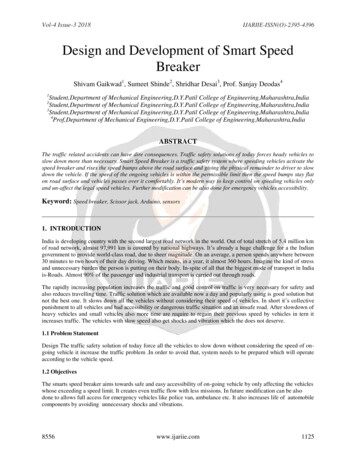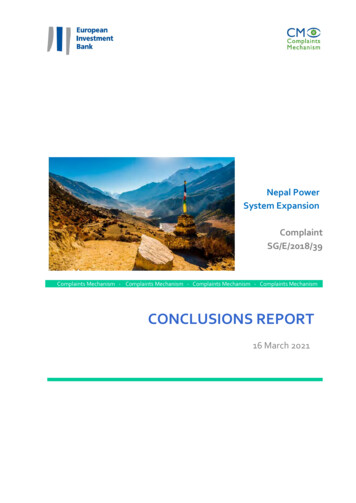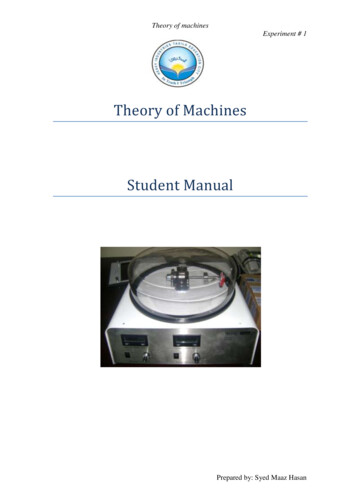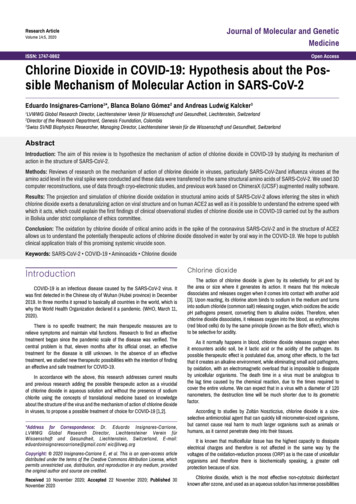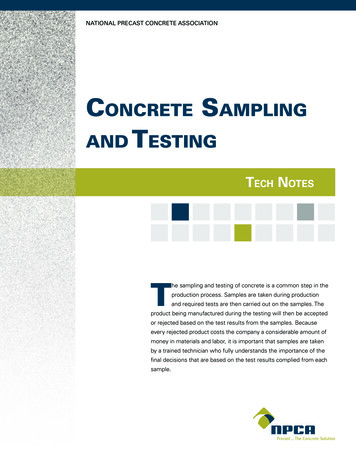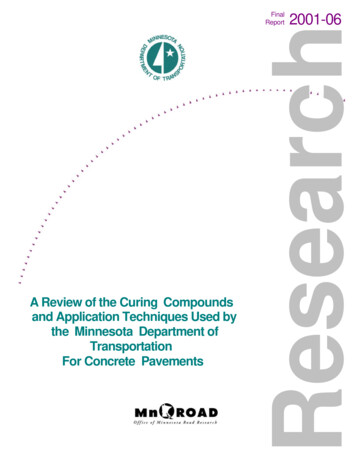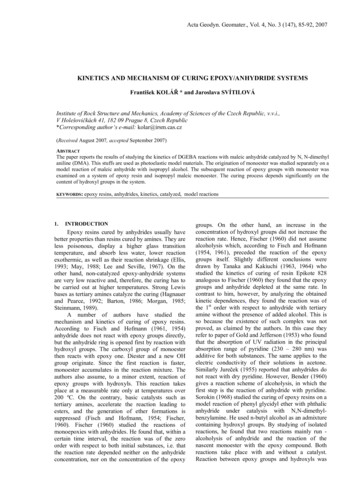
Transcription
Acta Geodyn. Geomater., Vol. 4, No. 3 (147), 85-92, 2007KINETICS AND MECHANISM OF CURING EPOXY/ANHYDRIDE SYSTEMSFrantišek KOLÁŘ * and Jaroslava SVÍTILOVÁInstitute of Rock Structure and Mechanics, Academy of Sciences of the Czech Republic, v.v.i.,V Holešovičkách 41, 182 09 Prague 8, Czech Republic*Corresponding author‘s e-mail: kolar@irsm.cas.cz(Received August 2007, accepted September 2007)ABSTRACTThe paper reports the results of studying the kinetics of DGEBA reactions with maleic anhydride catalyzed by N, N-dimethylaniline (DMA). This stuffs are used as photoelastic model materials. The origination of monoester was studied separately on amodel reaction of maleic anhydride with isopropyl alcohol. The subsequent reaction of epoxy groups with monoester wasexamined on a system of epoxy resin and isopropyl maleic monoester. The curing process depends significantly on thecontent of hydroxyl groups in the system.KEYWORDS:1.epoxy resins, anhydrides, kinetics, catalyzed, model reactionsINTRODUCTIONEpoxy resins cured by anhydrides usually havebetter properties than resins cured by amines. They areless poisonous, display a higher glass transitiontemperature, and absorb less water, lower reactionexothermic, as well as their reaction shrinkage (Ellis,1993; May, 1988; Lee and Seville, 1967). On theother hand, non-catalyzed epoxy-anhydride systemsare very low reactive and, therefore, the curing has tobe carried out at higher temperatures. Strong Lewisbases as tertiary amines catalyze the curing (Hagnauerand Pearce, 1992; Barton, 1986; Morgan, 1985;Steinmann, 1989).A number of authors have studied themechanism and kinetics of curing of epoxy resins.According to Fisch and Hofmann (1961, 1954)anhydride does not react with epoxy groups directly,but the anhydride ring is opened first by reaction withhydroxyl groups. The carboxyl group of monoesterthen reacts with epoxy one. Diester and a new OHgroup originate. Since the first reaction is faster,monoester accumulates in the reaction mixture. Theauthors also assume, to a minor extent, reaction ofepoxy groups with hydroxyls. This reaction takesplace at a measurable rate only at temperatures over200 ºC. On the contrary, basic catalysts such astertiary amines, accelerate the reaction leading toesters, and the generation of ether formations issuppressed (Fisch and Hofmann, 1954; Fischer,1960). Fischer (1960) studied the reactions ofmonoepoxies with anhydrides. He found that, within acertain time interval, the reaction was of the zeroorder with respect to both initial substances, i.e. thatthe reaction rate depended neither on the anhydrideconcentration, nor on the concentration of the epoxygroups. On the other hand, an increase in theconcentration of hydroxyl groups did not increase thereaction rate. Hence, Fischer (1960) did not assumealcoholysis which, according to Fisch and Hofmann(1954, 1961), preceded the reaction of the epoxygroups itself. Slightly different conclusions weredrawn by Tanaka and Kakiuchi (1963, 1964) whostudied the kinetics of curing of resin Epikote 828analogous to Fischer (1960) they found that the epoxygroups and anhydride depleted at the same rate. Incontrast to him, however, by analyzing the obtainedkinetic dependences, they found the reaction was ofthe 1st order with respect to anhydride with tertiaryamine without the presence of added alcohol. This isso because the existence of such complex was notproved, as claimed by the authors. In this case theyrefer to paper of Gold and Jefferson (1953) who foundthat the absorption of UV radiation in the principalabsorption range of pyridine (230 – 280 nm) wasadditive for both substances. The same applies to theelectric conductivity of their solutions in acetone.Similarly Jureček (1955) reported that anhydrides donot react with dry pyridine. However, Bender (1960)gives a reaction scheme of alcoholysis, in which thefirst step is the reaction of anhydride with pyridine.Sorokin (1968) studied the curing of epoxy resins on amodel reaction of phenyl glycidyl ether with phthalicanhydride under catalysis with N,N-dimethylbenzylamine. He used n-butyl alcohol as an admixturecontaining hydroxyl groups. By studying of isolatedreactions, he found that two reactions mainly run alcoholysis of anhydride and the reaction of thenascent monoester with the epoxy compound. Bothreactions take place with and without a catalyst.Reaction between epoxy groups and hydroxyls was
F. Kolář and J. Svítilová86Table 1 Alcoholysis of maleic anhydride by isopropyl alcoholT (oC)52657078Preexponential factorActivation energy (kJ)not proved. As the author reports, his results did notprove the conclusions of Tanaka and Kakiuchi (1963,1964), or Fischer (1960). Indeed, he found that theanhydride depleted during the reaction substantiallyfaster than the epoxy compound. This agrees with theexperiments of Fisch and Hofmann (1954, 1961).Sorokin considers the reaction of the epoxycompounds with monoester to be the crucial step. Thisreaction is of the 1st order with respect to the epoxycompound and catalyst, and of the zero order withrespect to monoester. The author does not mentionhow the tertiary amine works under alcoholysis,referring the reader to the paper of Gold and Jefferson(1953). At present is cure kinetics of epoxy resinstudied in general by the help of physical methods asthermogravimetric analysis (Wang and Shi, 2005),DSC (Chen et al., 2004; Kim and Lee, 2002),dielectric analysis (Chen et al., 2004) or Ramanspectroscopy (Rocks et al., 2004).In this paper we study the mechanism andkinetics of epoxy resins cured via anhydrides onmodel reactions. The changes in the concentration ofreaction components were monitored by chemicalmethods.4.69 10-41.06 10-31.38 10-32.18 10-32.15 105543. RESULTS AND DISCUSSIONALCOHOLYSISThe generation of monoester was modeled by thereaction of maleic anhydride with isopropyl alcohol.The reactions provided at temperatures of 52, 65 and78 ºC. The course of the reactions was monitored bydetermining the concentrations of anhydride andmonoester by double titration after Smith and Bryant(details in Jureček (1955)). The sigmoid shape of timedependence of the maleic anhydride conversion forsystems without DMA indicates that the reaction wascatalyzed by a reaction product (see Fig. 1). Thegeneration of diester was not observed under the givenconditions.The active substance is evidently the protonproduced by the dissociation of the generatedmonoester. The proton is first bound to the anhydridemolecule under generation of an oxonium cation,which then reacts with alcohol and monoesteroriginates (Ernest et al., 1959).The dissociation of monoester is very fast in bothways so that, soon after the beginning of the reaction,equilibrium sets up. The control step, therefore, is thereaction of the oxonium cation with alcohol. The7EXPERIMENTAL65-1DGEBA (CHS Epoxy 15 (present name is CHSEpoxy 520), epoxy group content 5.193, OH groups0.610 mol kg-1, SpolChemie, a.s. Czech Republic)was used as the initial resin. Maleic anhydride purris,isopropyl alkohol anhydrous (Sigma-Aldrich),N,N-dimethyl aniline purris. (Sigma-Aldrich).Mono(isopropyl) maleic ester was prepared by noncatalyzed reaction of maleic anhydride and isopropylalcohol in equimolar amount as described in Ernest etal. (1959). All reactions took place in closed flasks attemperatures of 65 to 100 ºC under mixing with amagnetic mixer. Samples collected in the course of thereaction were dissolved in benzene, and the content ofepoxy groups was determined by HBr titration inacetic acid Durbetaki (1956). The contents ofanhydride and monoester were determinedsimultaneously by natrium hydroxide and natriummethanolate titration described in Jureček (1955). Theconcentration of hydroxyl groups in the initial resinwas determined by acetylation after Chachapuridze(1969).k7 (kg mol-1s-1)1.07 10-41.60 10-45.21 10-42.45 10-42030CA (mol kg )2.k4′ (kg3/2 mol-3/2 s-1)K3 (kg mol-1)0.0880.2200.2730.4201.40 10857435226517800500010000150002000025000time (s)Fig. 1Alcoholysis of maleic anhydrid byisopropyl alcohol without DMA,numbers at curves are reactiontemperature in oC.
KINETICS AND MECHANISM OF CURING EPOXY/ANHYDRIDE SYSTEMSfollowing equation can then be derived for thealcoholysis kinetics:dCCM A CA COH ( k1 k4′ K 3 )dt1 K 3 CA87OCOCNR3(1)wherek4′ k4 K 2O(A*)At the beginning of the reaction the rate of thealcoholysis is very low, hence the inequalityk1 k4′ K 3 . Equation (1) was solved by numericalintegration using the Runge-Kutta method. Constantsk4′ and K 3 were optimized using Marquardt’s method.The values of the constants found are given in Table1. Figure 1 shows the time dependence of anhydrideconcentration fitted with integrated function (1). Thetemperature dependence of the constants wasdetermined using Arrhenius’ and van Hoff’s relations.Alcoholysis of anhydrides is catalyzed bytertiary amines. Whereas the product of the reaction ofacetic anhydride with pyridine was not proved [10]the reaction of maleic anhydride with N,N-dimethylaniline undoubtedly takes place. Evidence of this isthe intensively orange coloration appearing after thetwo substances have been mixed. Neither maleicanhydride, nor N,N-dimethyl aniline absorb in thevisible part of the spectrum. Let us assume thereaction:MA nDMAK6MA(DMA) nThe equilibrium concentrationdepends on the molar fraction DMA as:{(2)MA(DMA)n} MA ( DMA )n K 6 C o (1 X DMA ) MA ( DMA )n {C XoDMA} n MA ( DMA )n nScheme 1: Strukture of the MA (DMA)the positive partial charge on the carbon neighboringto nitrogen. Let us assume a reversible reaction, inwhich the initial substances and the product are inscheme 2.The system of equations, describing the kineticsof these reactions, can be simplified if one assumesstationary concentrations CA* , CM* and constantconcentration of active DMA particles:k K Co C CdCA 7 6 DMA A OH rodt1 K 6 CA K 8 CM(4)where ro is the rate of non-catalyzed reaction(Equation (1)).Equation (4) can be conveniently approximatedby a 1st-order equation, to which it will transfer, ifK 6 CA 1 K8CM :dCAoCOH ro k7 CDMAdt(5)The time dependences of maleic anhydride forvarious amounts of catalyst at a temperature of 65 ºCare shown in Fig. 2. Rate constants k7 determined byMarquardt’s method are given in Table 1.(3)65-1C A (mol kg )where XDMA is the molar fraction of DMA andoC o CAo CDMA, superscript o indicates the initialconcentrations.Maximum of function (3) is at X DMA n (n 1) .Using the Lambert-Beer’s law we altered Equation (3)for absorbances. The solutions of MA and DMA inbenzene were mixed in ratios to produce mixtures ofdifferent DMA molar fractions at constant totalconcentration of both components C o . Thesesolutions were measured in the visible part of thespectra at several wavelengths. The maxima of thecurves corresponded to XDMA 0.5, and thus n 1. Itmay be assumed that the substances to be generatedwill have the following structure see scheme 1.Alcoholysis is a nucleophilic reaction and it isevident to take place advantageously, via semiproductA*, in the presence of tertiary amine due to increase of400.06530.1290.19120.25210050001000015000time (s)Fig. 2Alcoholysis of maleic anhydrid by isopropylalcohol catalyzed DMA, numbers at curvesare catalyst contents in mol kg-1.
F. Kolář and J. Svítilová88OOCOCCNR3OOC OK6R3N(A*)OOCO CδδR'OHk7NR3OR3NHCOCOR'O(A*)OOCCOOR3NHOHCK8-1 OR'R3NOR'CO(M*)Scheme 2: Catalytic reaction of alcoholysis.The reaction of monoester (generated byalcoholysis) with epoxy groups was studied on themodel reaction of CHS Epoxy 15 resin withMono(isopropyl) maleic ester (M). The reactions tookplace in present DMA catalyst as well as without acatalyst, at temperatures of 65, 78, 89 and 100 ºC. Thereactions were monitored by measuring theconcentration of epoxy groups and of monoester. Theepoxy groups were determined by HBr titration inacetic acid (Durbetaki, 1956). The content ofmonoester was determined by double titration afterSmith and Bryant (Jureček, 1955). The rate ofdepletion of both reaction components is identical. Onthe whole, the reaction is of the second order: dCEdC M k 9 CE CMdtdtkinetics observed correspond to the data reported inthe literature. According to (Ernest et al., 1959) theepoxy groups react with weak acids mostly with theSN2 mechanism. Kinetics of the second order ingeneral was also observed by Sorokin, when hestudied the non-catalyzed reaction of phenyl glycidylether with caproic acid (Sorokin, 1968).32,52C E (mol kg-1)REACTION OF CHS EPOXY 15 RESIN WITHMONO(ISOPROPYL) MALEIC ESTER781,5891(6)where CE and CM are the concentrations of epoxygroups and monoester, respectively.The kinetic constants for the monitoredtemperatures are given in Table 2. The timedependences of the conversion of epoxy groups forvarious reaction temperatures are shown in Fig. 3. The651000,50050001000015000200002500030000time (s)Fig. 3Reaction of CHS Epoxy 15 resin andmono(isopropyl) maleic ester without acatalyst.
KINETICS AND MECHANISM OF CURING EPOXY/ANHYDRIDE SYSTEMS89Table 2 Reaction of CHS Epoxy 15 resin and mono(isopropyl) maleic esterT (oC)065070078089100Preexponential factorActivation energy (kJ)k9 (kg mol s-1 )6.35 10-69.97 10-62.07 10-54.27 10-59.33 10-51.37 10780OCk10 (kg mol s-1 )1.67 10-32.43 10-33.35 10-35,57 10-38.98 10-36.56 10449OHOOR3NHC COR'O(M*)H2CCHR''OOk10CH2CHR'' CR3NOR'OScheme 3: Reaction schema of epoxy and M*.The presence of N,N dimethyl aniline leadsto the acceleration of the reaction. Fig. 4 shows theconcentrations of the epoxy groups at a temperature of65 ºC and various catalyst concentrations as functionsof time.Let us consider the reaction scheme 3. Thecorresponding mathematical model can be simplifiedby assuming CM* to be stationary and theconcentration of active particles DMA to be constant:3,0C E (mol 00001500020000time (s)Fig. 4Reaction of CHS Epoxy 15 resin andmono(isopropyl) maleic ester with DMAcatalystk K Co C CdCE 10 8 DMA E M1 K 8 CMdt(7)Since the DMA concentration as compared to themonoester concentration is very low, all of the catalystis certain to be practically present in bound form. Therate equation can then be simplified as:dCEo k10 CDMACEdt(8)This agrees with Sorokin’s results (Sorokin,1968) who found that the reaction of n-butyl phthalatewith phenyl glycidyl ether under catalysis by tertiaryamines displayed kinetics of the first order withrespect to the epoxy compound and of zero order withrespect to monoester. Kinetics of the 1st order was alsoobserved for the basic catalyzed reaction of epoxycompounds with caproic acid (Sorokin, 1968). Theequation for the overall rate of epoxy groups depletionwas solved by numerical integration using the RungeKutta method, and constants k9 and k10 were optimizedby Marquardt’s method. The values of the constantsare given in Table 2.REACTION OF CHS EPOXY 15 RESIN WITH MALEICANHYDRIDEThe course of the curing of CHS Epoxy 15 resinwas studied. The content of the epoxy groups duringcuring was monitored by HBr titration in acetic acid(Durbetaki, 1956). The contents of anhydride andmonoester were determined by double titration(Jureček, 1955). The reaction of the epoxy groups
90F. Kolář and J. SvítilováTable 3 Reaction of maleic anhydride with CHS Epoxy 15 resink7 (kg mol s-1)01.53 10-0202.23 10-0203.24 10-0207.8 10656runs via monoester, generated by the reaction ofanhydride with OH groups (always present in epoxyresins). The fact that these reactions, i.e. alcoholysisand reaction of epoxy groups with monoester, doindeed take place was verified, on the one hand, byanalysis of curing mixtures, and on the other bystudying both reactions separately. The followingbalances exist among the concentrations of the epoxygroups, maleic anhydride, OH groups, DMA,monoester and diester:CEo CE CDCAo CA CM CDo COH CMCOH(9)o CDMA CA* CM*CDMABased on the reaction schemes proposed above,one is able to derive the rate equations of depletion ofepoxy groups and anhydride in the following form: oCA COHdCA k7 K 6 CDMA dt1 K 6 CA K 8 CM oCE CMdCE k10 K8CDMA 1 K 6 CA K 8 CMdt(10)The used CHS Epoxy 15 resin is characterizedby a very low content of OH groups, and the curingrate is limited by their low concentration. Also theconcentration of monoester will be low throughout thewhole period of the reaction. Assuming that no otherreactions are taking place, in which these substancesoholds between theoccur, the inequality CM COHconcentrations. Based on the approximation of thesteady state (Kraus et al., 1978) we assume that, aftera brief induction period, the concentrations ofmonoester and of the OH groups will stabilize at aconstant value, and that the following equations willhold for the rate of depletion of the epoxy groups andanhydride:dCAo k7 CDMACOHdtdCEo k10′ CDMACMdtk'10 ( kg mol s-1 )05.71 10-0308.45 10-0301.61 10-0209.0 10979where k10′ k10 K8K6(11)Hence, if the content of the OH groups in theepoxy resin is very low, the reaction may be referredto as of zero order with respect to both initialsubstances. Fischer (1960) describes the kinetics ofthe reaction of monoepoxy substances withanhydrides by a zero-order equation. Tanaka andKakiuchi (1963, 1964) found that the Epikote 828resin (0.8 mol OH/kg) displayed the same depletion ofanhydride and epoxy groups.Kinetics of reaction of maleic anhydrite withCHS Epoxy 15 resin are in Fig. 5. Rate constants k6and k’10 of reactions CHS Epoxy 15 resin and MAwere determined from integrated equations (11). Theresults are given in Table 3.To determine the effect of the OH concentrationon the curing process, we added an amount ofisopropyl alcohol to the reaction mixture to bring itsconcentration corresponding to the concentrations ofanhydride and of the epoxy groups. The timefunctions of the concentration of monoester display ashape typical for the subsequent reactions with one3,532,5C A, C E, C M (mol kg-1)T (oC)657078Preexponential factorActivation energy 020000time (s)Fig. 5Curing of Epoxy 15 resin by maleic anhydrideoo(CEo CAo 3.38, COH 0.397, CDMA 0.029molkg-1 ),time dependence of epoxy groups, maleicanhydride and monoester.
KINETICS AND MECHANISM OF CURING EPOXY/ANHYDRIDE ,00500010000150002000025000C A, C E , C M (mol kg -1)-1C A, C E, C M (mol kg )AnhydrideAnhydride2.0Monoester1.51.0time (s)0.5Fig. 6Curing of Epoxy 15 resin by maleic anhydritein presence of isopropyl alcoholoo(CEo CAo COH 2.842, CDMA 0.026mol kg-1 ) ,time dependence of epoxy groups, maleicanhydride and monoester.0.001)k7 (kg mol s )K6 (kg mol-1)k10 (kg mol s-1 )K8 (kg mol-1)1)2)10000150002000025000tim e (s)Fig. 7Table 4 Reaction of maleic anhydride with CHSEpoxy 15 resin enriched in hydroxyles.-15000Curing of Epoxy 15 resin reacted formerlywith mono(isopropyl) maleic ester,oo(CEo CAo COH 1.026, CDMA 0.029molkg-1 ) .2)-403.13 1013.2001.10 10-200.141.04 10-38.302.31 10-20.08CHS Epoxy 15 resin with isopropyl alcoholCHS Epoxy 15 resin reacted formerly withmono(isopropyl) maleic estersemiproduct (see Fig. 6). The rate of alcoholysis is notlimited, in this case, by the low concentration ofhydroxyls, the depletion of anhydride is faster than thedepletion of the epoxy groups, and monoester,therefore, accumulates in the reaction mixture. Theexperimental points were fitted with integratedfunctions (10). The values of the constants are shownin Table 4.The concentration of the hydroxyl groups waseffected also by partial reaction of the epoxy resinwith mono(isopropyl) maleic ester in an amount, inwhich the resultant hydroxyl concentration wouldcorrespond to the concentration of the remainingepoxy groups. The resin treated in this manner, wassubjected to reaction with maleic anhydride. Thereaction took place in xylene with 0.156 mol DMA/kg as catalyst, at a temperature of 75 ºC. Theappropriate time dependences of concentrations of E,A and M are shown in Fig. 7.Fisch and Hofmann (1954, 1961) detecteddependences of this type. These authors studied thereaction kinetic of curing Araldite 6060 resin, whichhas a comparable content of hydroxyl and epoxygroups (2.8 and 2.5 mol/kg). Also Sorokin (1968) whostudied the reaction of equimolar amounts of phenylglycidyl ether, phthalic anhydride and n-butyl alcoholarrived at the same results.REACTION OF EPOXY GROUPS WITH HYDROXYLSThe reaction of hydroxyls with epoxy groupswas studied on the reaction of CHS Epoxy 15 resinwith isopropyl alcohol under DMA catalysis, as wellas without a catalyst at temperatures of 65 and 80 ºC.During the monitored period (about 8 hours) not evenin a single case did a provable depletion of epoxygroups occur. This agrees with the finding of Sorokin,who observed no reaction of epoxy groups withalcohols either (Sorokin, 1968).4.CONCLUSIONThe paper reports the results of research thekinetics of reactions of CHS Epoxy 15 resin withmaleic anhydride and N,N-dimethyl aniline (DMA)catalyst. The origination of monoester was studiedseparately on a model reaction of maleic anhydridewith isopropyl alcohol. This is acid catalyzed reaction,in which the proton concentration is determined by thedissociation of the originating monoester. The rate ofthe DMA catalyzed reaction can be described by afirst-order equation. The subsequent reaction of theepoxy groups with monoester was modeled by anCHS Epoxy 15 resin and mono(isopropyl) maleicester. The non-catalyzed reaction is of the first orderwith respect to both reactants. The rate of the DMAcatalyzed reaction can be described by a first-orderequation with respect to the epoxy groups and by azero-order equation with respect to monoester.The curing of epoxy resins by maleic anhydridecatalyzed by DMA depends on the content ofhydroxyls. If the concentration of anhydride, epoxy
92F. Kolář and J. Svítilovágroups and hydroxyls is comparable, the depletion ofanhydride is faster than that of the epoxy groups. Thetime dependence of monoester has a form typical forthe subsequent reactions. A relatively short time afterthe beginning of the reaction, the anhydride vanishesfrom the reaction mixture and only the reaction ofepoxides with the monoester continues. In terms ofkinetics this reaction is of the first order. The lowconcentration of OH groups restricts the rate ofalcoholysis as well as the reaction of monoester withthe epoxy groups. It appears that the discrepancies incuring kinetics and mechanism are related to thedifferent content of OH groups in the resins studied.ACKNOWLEDGEMENTThis study has been supported by the InstituteResearch Plan of the IRSM CAS CZNo. AVOZ30460519.REFERENCESBarton, J.M. and Greenfield, D.C.L.: 1986, BritishPolym. J., 18, 51.Bender, M.L.: 1960, Chem. Rew., 60, 1.Chatchapuridze, N.A.: 1969, Plast Massy, 4, 57.Chen, W.Y. et al.: 2004, Polymer, 45, 6897–6908.Durbetaki, A.J.: 1956, Anal. Chem., 28, 2000.Ellis, B.: 1993, Chemistry and technology of epoxyresins, Glasgow, Blakie Academic Professional.Ernest, I., Heřmánek, S. and Hudlický, M.: 1959,Preparative reactions in organic chemistry,Prague, Czechoslovak Academy of Sciences.Fisch, W. and Hofmann, W.: 1954, J. Polym. Sci., 12,497.Fisch, W. and Hofmann, W.: 1961, PlasticsTechnology, 28, 8, 29.Fischer, R.F.: 1960, J. Polym. Sci., 44, 155.Gold, V.E. and Jefferson, CJ.: 1953, J. Chem. Soc.,1049.Hagnauer, G.L. and Pearce, P.J.: 1992, ACS Symp.Ser., 221, 193.Jureček, M.: 1955, Organic Analysis, Prague,Czechoslovak Academy of Sciences.Kim, W.G. and Lee, J.Y.: 2002, Polymer, 43, 5713–5722.Kraus, W., Schneider, P. and Beránek, L.: 1978,Chemical kinetics for engineers, Prague, SNTL.Lee, H. and Neville, K.: 1967, Handbook of epoxyresins, New York, McGraw-Hill.May, C.A.: 1988, Epoxy resins, New York, MarcelDekker.Morgan, R.T.: 1985, Adv. Polym. Sci., 72, 1.Rocks, J., Rintoul, L., Vohwinkel, F. and Georgie, G.:2004, Polymer, 45, 6799-6811.Sorokin, M.F.: 1967, Kinetika i kataliz, 3, 512.Sorokin, M.F.: 1968, Kinetika i kataliz, 3, 548.Steinmann, B.J.: 1989, Appl. Polym. Sci., 37, 1753.Tanaka, Y. and Kakiuchi, J.: 1964, J. Polym. Sci.,Part A, 3405.Tanaka, Y., Kakiuchi, J.: 1963, J. Appl. Polym. Sci.,37, 1063.Wang, Q. and Shi, W.: 2005, Polymer Degradationand Stability.
aniline (DMA). This stuffs are used as photoelastic model materials. The origination of monoester was studied separately on a . 0 5000 10000 15000 20000 25000 time (s) C A (mol kg-1) 52 65 78. KINETICS AND MECHANISM OF CURING EPOXY/ANHYDRIDE SYSTEMS 87 following equation can then be derived for the alcoholysis is very low, hence the inequality
